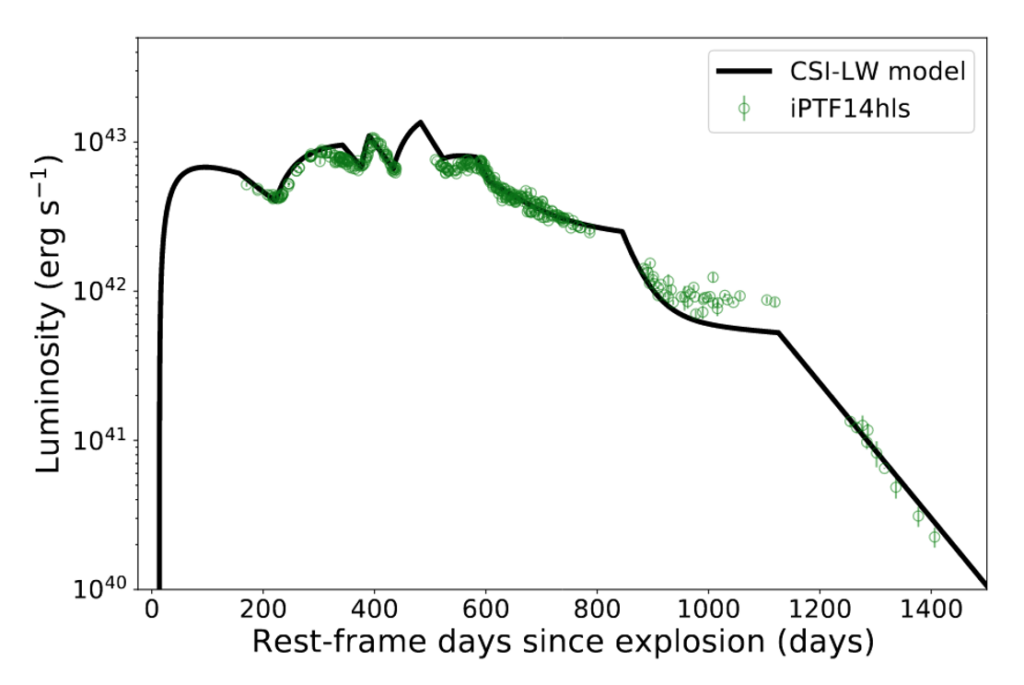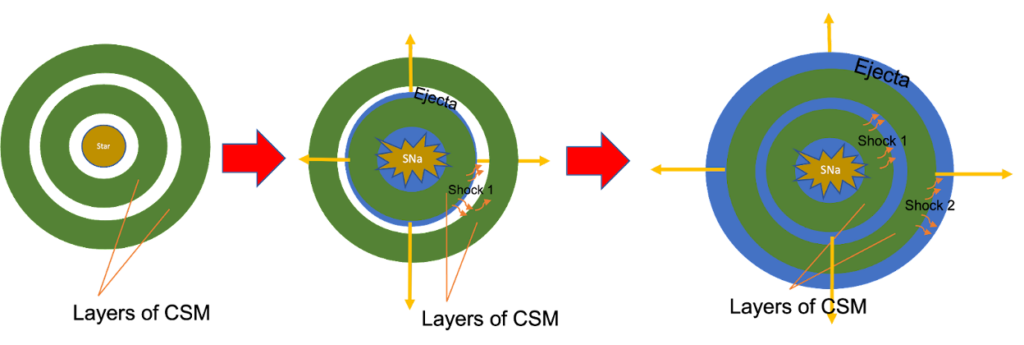Authors: Ling-Jun Wang, Liang-Duan Liu, Wei-Li Lin, Xiao-Feng Wang, Zi-Gao Dai, Bing Li, and Li-Ming Song
What is a supernova?
When a high-mass star reaches the end of its life, it dies in a very bright and violent explosion called a core collapse supernova (CCSN). Check out this amazing bite that talks about simulating core collapse! As a high-mass star evolves through its stages of life, it slowly fuses hydrogen into heavier and heavier elements in its core, moving up the periodic table until it ends up with an Iron core. At this point, it looks like an onion, with many, many layers, like in figure 1. Until this point, the star’s life has been a game of balance. The balance between the inward force of gravity trying to collapse the star and outward radiative forces keep the star in balance and at constant size.

Once the star produces iron, however, it stops fusing into heavier elements. Iron cannot be fused into anything heavier without the addition of any extra energy. Therefore, once there is enough iron in the core of the star, nuclear fusion stops occurring, and the outflow of radiative pressure from the center of the star ceases. This causes the core of the star to collapse under its own gravity, creating the CCSN.
What if the core is very, very, very hot?
Because internal energy production stops, nothing can hold up the star, and the star starts to collapse. In a CCSN, the internal energy production stopped because the star started to create iron. But are there other reasons that internal energy production can stop? Imagine an even more exotic situation:
Say you have a very massive star (100 solar masses or so). The core temperature gets so hot that there are photons with high enough energy to undergo pair production, the transformation of the photon into an electron-positron pair. To undergo pair production, the photon needs to have at least as much energy as the total rest mass of an electron-positron pair.
Figure 2: Pair production caused by a very high energy (>1 MeV) photon colliding with a nucleus, resulting in the production of a positron and electron, and the destruction of the photon. Credit: Tornga, Shawn. (2010). https://digitalrepository.unm.edu/ne_etds/48
If the stellar core is hotter than ~2 x 109 Kelvin, there is a significant number of these very high-energy photons that can start pair production. Therefore, at these core temperatures, many photons are lost to pair production, reducing radiative pressure, and the core starts contracting. When the core contracts, it starts releasing energy, heating up the outer layers of the star, and speeding up thermonuclear reactions in those layers. Eventually, this increase in reaction rate will re-establish equilibrium in the star. During this process (called a pulsation), the star usually “burps off” some material, releasing a layer of ejecta that expands into its surrounding environment. After equilibrium is re-established, the core temperature climbs again to ~2 x 109 Kelvin, and the process happens again, resulting in another pulsation. Many such pulsations can occur in the last stages of the star’s life, and each pulsation causes the star to “burp” off a layer of material into the surrounding environment. Eventually, once the star produces iron in its core and can no longer hold itself up against gravitational collapse, it undergoes a core collapse supernova. Like in all core collapse supernovae, fast-moving ejecta is released from the star, which then subsequently collides with the layers of mass that was lost by the star during its pulsations. This is called a pulsational pair instability supernova (PPISN). See this awesome bite about simulating the spectra of pair instability supernova!
How did iPTF14hls explode?
The authors of this paper think they can explain the unique supernova iPTF14hls as being a PPISN. This supernova has a very bumpy and strange light curve (its observed brightness plotted over time).

The authors think the bumps in the light curve are caused by the supernova’s ejecta interacting with circumstellar mass (CSM), created by layers of mass that were burped off by the star during pulsations. As the ejecta leaves from the star’s surface, it passes through multiple layers of CSM, each of which creates a shockwave, resulting in a bump in the light curve.

Results and future avenues
The authors describe this supernova using models with six separate shocks, corresponding to six layers of CSM. In all, their models predict the original star had a mass of well over 200 solar masses, and each layer of csm must have been created by the loss of several tens of solar masses! The star would have had to lose several layers of mass for hundreds of years before going supernova to create so much CSM.
This supernova had a very peculiar light curve, given all the bumps, and how long it took to decay. The authors find that it can be best explained as a PPISN. This supernova opens the gates to better understanding the evolution of the most massive stars, and how they explode when they die. By understanding these massive star explosions, we can better understand how these uncommon stars live. We expect to see such high mass stars only in the early universe, so by studying such strange supernovae, we can understand better how the earliest stars in the universe must have died.
Astrobite edited by Jack Lubin and Lili Alderson
Featured image credit: Karthik Yadavalli




